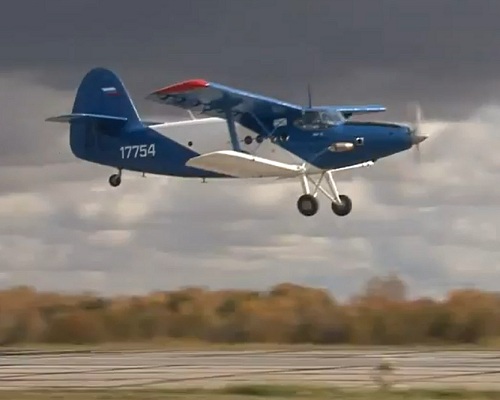Readers may remember that in one of my earliest Weekend Wings articles, I mentioned the Antonov An-2 biplane.
It first flew in 1947, powered by a Shvetsov ASh-62 radial engine (copied from the US Wright R-1820 Cyclone engine) producing 1,000 horsepower. It's believed that over 20,000 have been built to date, including licensed production in China (as the Shijiazhuang Y-5), Poland and possibly elsewhere. There are still occasional production runs in Poland (using stored parts), and possibly in China too, giving the An-2 the longest production run of any biplane in history. The basic version can seat up to twelve passengers or carry up to two tons of freight (depending on fuel load and other factors). Wikipedia points out that the An-2 has been adapted for many other purposes, including "hopper-equipped versions for crop-dusting, scientific versions for atmospheric sampling, water-bombers for fighting forest-fires, flying ambulances, float-equipped seaplane versions, and lightly armed combat versions for dropping paratroops".
The An-2 slightly predated the de Havilland Canada DHC-3 Otter, and had almost the same capacity. Both aircraft were designed for much the same mission - a general-purpose utility transport suitable to fly passengers and cargo into and out of rough terrain, in areas where airline transport simply wasn't an option. Both have been adapted for use on skis and floats, and both are still in service around the world, including the USA. (I've flown aboard a couple of An-2's in Africa.) Both have also been modified to use turboprop engines in the past - the Otter using a PT6, M601 or TPE331 engine, and the An-2 under a new designation as the An-3 (shown below - image courtesy of Wikipedia), using a Glushenkov TVD-20-03 engine. However, the latter was neither very successful nor very popular with users.
You'll understand, therefore, that I was intrigued to read this report on Flight Global's Web site today.
A Russian aviation design institute has completed initial testing of an Antonov An-2 biplane re-engined with a US-made Honeywell Aerospace TPE-331 turboprop engine and Hartzell five-blade propeller, in an attempt to cut operating costs and improve performance.
The Novosibirsk-based Chaplygin Siberian Aeronautical Research Institute began tests in February of the turboprop-fitted An-2, offering equivalent power to the aircraft's standard ASh-62 nine-cylinder radial engine, but with less weight and drag and using cheaper kerosene fuel.
The aircraft had a shorter take-off run, and was steadier and easier to control, the institute says.
. . .
Russia has a chronic need for a new generation of regional aircraft to service remote communities in areas with poor road and rail links. Regional aviation has fallen into steep decline since the collapse of the USSR in 1991.
There's more at the link. (An earlier report mentioned that Russian authorities want to modernize the An-2 and Yak-40 aircraft without getting approval from their original design bureaux, due to difficulties experienced in that process.) Here's an image of the Honeywell-engined An-2 prototype, captured from the video clip below.
This offers a tantalizing hope for a new generation of highly cost-effective bush aircraft, if regulatory approval for their use can be obtained (the FAA in the US has never approved the An-2 for commercial operations). The original aircraft, built in their thousands, are available at very low cost. If a modern low-maintenance, low-running-cost turboprop engine can be fitted, and the aircraft's notoriously deficient instruments upgraded and its notoriously tricky handling improved, a very capable and cost-effective bush plane might result - something many parts of the world would appreciate.
Here's a video of flight trials of the Honeywell-engined An-2 in Siberia.
I'd like to see this conversion succeed. It'd be great fun to fly in the world's largest biplane again - this time rather more smoothly and quietly than its original radial engine permitted in the past!
(If you'd like to see more of the An-2, there's an entire YouTube channel devoted to video clips of this aircraft.)
Peter



7 comments:
"making it the most-produced aircraft in history."
I think that should be longest production run in history. Other aircraft have had more built in terms of numbers, but over a shorter period.
@Chris: You're right, of course. Wikipedia makes that clear:
http://en.wikipedia.org/wiki/List_of_most_produced_aircraft
I've updated the article accordingly.
AN-2's are awesome. I came across this great website just a few days ago:
http://an2flyers.org/
Regretably they can be registered only as Experimental in the US, so no commercial use.
Don in Oregon
This is one of the only a/c that I'd like to own. I know it'd be a pain pulling the prop to clean out the cylinders, but that's what you pay to have a WW2 round engine.
I think there is even a limit to how far from home plate your allowed to fly it.
It sucks avgas like a hose, but man, what a beautiful bird. Thanks for awakening the desire again!!!!
I watched one try to land in a crosswind one day... he finally landed on the cross taxiway (and stopped) because he couldn't control it on the runway itself...
You sir are a heathen. How dare you prefer the shrill screaming banshee of a turbine to the unbelievable sexy rumble of a well tuned radial engine.
@Oz: You just wait until you've flown in one. Every rivet and joint vibrates (the plane's and yours!); the noise is incredible; the cabin leaks (both air and water) like a sieve, so you finish your journey dusty in hot weather and wet in rainy weather; the seats are refined instruments of torture, so that it's both painful to sit through a flight and even more painful to get up and out afterwards; and the constant vibration and smell of gasoline and oil does something horrible to your innards. Both times I've flown on An-2's I've had the runs something fierce afterwards!
I like the planes for their practicality, but I'll lose that big vibrating gas-guzzler up front in a heartbeat, thank you very much!
Post a Comment